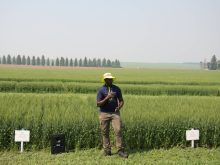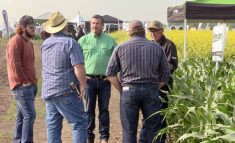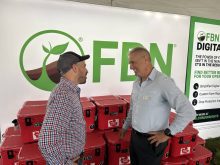Company has made deals with dozens of gov’ts to set up struvite extraction units; this will be the third on the Prairies
Glacier FarmMedia – The City of Winnipeg is getting into the fertilizer manufacturing business.
When the upgrades to its waste water treatment facility are complete in 2030, they’ll include equipment to extract agricultural-grade phosphate fertilizer from the struvite in the city’s waste water.
In medical circles, struvite is better known as a culprit behind kidney stones.
Read Also

Agri-business and farms front and centre for Alberta’s Open Farm Days
Open Farm Days continues to enjoy success in its 14th year running, as Alberta farms and agri-businesses were showcased to increase awareness on how food gets to the dinner plate.
For municipal public works departments, it’s a headache, appearing as white or greyish crystals that can cause scaling and blockages in pipes or equipment if not properly managed.
Environmentally, the nutrient contained in struvite, which includes phosphate, ammonium and magnesium, can be a problem if it leaks into local waterways, contributing to excess nutrient loading. That’s a big point in Manitoba, where nutrient concentrations and nutrient-linked algal blooms in Lake Winnipeg consistently garner attention.
In an effort to protect the lake, the City of Winnipeg uses a ferro-chloride process that precipitates phosphate out of waste water. The result is a sludge made up of iron phosphate.
“The benefit to them is they protect their waterways by using that type of technology,” said Mark Silvanovich, vice-president of sustainable business operations for fertilizer company Ostara.
“But the disadvantage is that it’s forming a chemical sludge that’s a waste product that would typically go to a landfill. It’s not really delivering a value out of those nutrients.”
Ostara’s equipment will spearhead the City of Winnipeg’s waste-water nutrient reclamation efforts using technology that arose from research done at the University of British Columbia in the early 2000s.
“The technology we developed was based on a recognition that this material, struvite, has a nutrient content and the potential to be a fertilizer, and not just any fertilizer, but a slow-release fertilizer with some special properties,” Silvanovich said.
The firm, which markets itself as a sustainable fertilizer business, has made deals with dozens of governments globally to set up struvite extraction units, including two on the Canadian Prairies: Saskatoon and Edmonton. The Saskatoon facility was the first such commercial operation in Canada.
According to the City of Saskatoon website, that plant puts out enough nutrient for 240 to 350 tonnes of the company’s slow-release fertilizer, marketed under the moniker Crystal Green Pearl. The city then gets a cut of the sales revenue from that fertilizer.
The price tag for its project was $4.5 million, and Saskatoon expected its fertilizer revenue to cover the cost of operating the reclamation equipment.
Winnipeg is getting a similar deal. A spokesperson for the city said revenue from the sale of the struvite will be used to offset operating costs of the upgrades.
Ostara’s reclaimed nutrient fertilizer is not water soluble, Silvanovich said.
“That’s what prevents nutrient loss from soil, tie-up runoff or leaching into waterways, and it’s really beneficial not only to crops agronomically but also environmentally.”
It also brings the concept of a closed loop on agricultural phosphorus closer to fruition.
“What we’re doing is we’re allowing phosphorus to essentially be upcycled back into the community,” he said. “If we look at the current phosphorus cycle without our technology, you’re essentially allowing this nutrient to escape back out into waterways and ultimately settle out into sediment, and it’s effectively lost at this point.”
There is growing interest in the technology, Silvanovich noted, largely driven by the same factors that saw the City of Winnipeg sign up. More local governments are looking for nutrient removal.
“We’re seeing similar types of thought processes to address algae blooms and other types of impacts that nutrients could have.
“Our technology essentially diverts those nutrients to a reactor before those (struvite) deposits form, and it harnesses that same reaction in a controlled manner to form that mineral deposit in the form of fertilizer that can then be harvested and dried and bagged out and sold as a commercial fertilizer.”
Agriculture is also looking for more efficient and slow-release fertilizer options. Much of Ostara’s fertilizer demand globally is coming from organic farms. In Canada, however, the product is awaiting certification for the organic market.
The source of struvite is the main bone of contention. Deriving fertilizer from human waste has raised concerns about contamination. However, the company says its process follows exacting standards, and the final product is high quality.
“When I look at our quality control program and all of the testing and the results, our fertilizer is actually of higher quality and made to a higher standard in terms of all kinds of contamination when compared to more traditional nutrient sources or conventional fertilizers,” Silvanovich said.
Joanne Thiessen Martens, a University of Manitoba research scientist, has explored the performance of struvite-based fertilizer. Her results are promising.
Trials conducted from 2017 to 2019 found that struvite increased crop yields, particularly in alfalfa. Because it doesn’t easily dissolve, the yield benefits would likely be evident in subsequent years, even when no struvite was added.
Her current work builds on the results of those first trials.
Because of its slow-release properties, Thiessen Martens is looking at the potential role of struvite as a long-term phosphorus source in perennial crops. She is studying perennial intermediate wheatgrass, a species the university’s breeding program is developing for grain production.
“The long-term phosphorus supply is a really promising characteristic of this fertilizer that could be really well suited to a perennial crop, where you apply it at the beginning of a multi-year stand and then it keeps applying phosphorus for a few years,” she said.
Her team is studying the mechanisms that allow plants to take up phosphorus from struvite.
“Ostara talks about how organic acids released from plant roots are needed to dissolve the struvite,” she said. “There hasn’t actually been a lot of published research, at least that I’ve seen, that actually demonstrates this happening.”
Based on Ostara’s claims, a crop that exudes a lot of organic acids (mostly citric and malic acids) from their roots would respond well to a struvite fertilizer. That led Thiessen Martens to compare buckwheat, fababeans and field peas — plants that release those compounds.
Early results seem to indicate complexities that need more study, she noted. Peas and fababeans produced more of the requisite organic acids, but yields went in the other direction.
“What I saw was the peas and the fababeans really didn’t respond much. Their biomass production was no greater than an unfertilized control, even on a really low phosphorus soil. But the buckwheat responded very nicely to the struvite,” she said.
Thiessen Martens is doing further work to determine why trials didn’t follow the predicted path.
“We’re tracking the exudates from buckwheat earlier in the season,” she said. “It’s possible that, with the sampling dates we did in that past research, that we missed something that was happening earlier.”
















